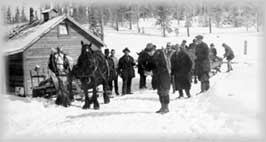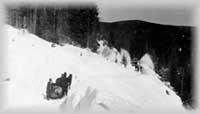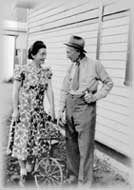 |
|
|

![]()
![]()
Fred Wells was a prospector in every sense of the word. Like other prospectors, the reason for mining was not necessarily only striking it rich, but the adventure and chances taken along the way. Like a compulsive gambler who cannot stop, Fred was a prospector with a zest for the search, and a leading mining engineer in British Columbia. Not only was he determined and focussed on discovering the motherlode of gold, but he possessed great physical strength as well. Fred favoured travel by snowshoe around his claims and the surrounding area, well into his seventies, and could still outclimb most of the men in his camp. He held the title of Snowshoe Champion of British Columbia three years in a row from 1898 to 1890. Unlike many gamblers, Fred did not indulge in smoking or drinking as a lifestyle. Furthermore, he would not tolerate either in his presence, according to fellow miner Ted Baynes6.
Geologists did not agree with Wells in regards to his belief there was gold in Cow Mountain. The Department of Mines actually referred to Fred as "an opinionated prospector, devoid of geological knowledge." He was refused the right to sell stock in British Columbia by the provinical government, but Fred persisted with the help of his friends and financiers. Newspaper reports throughout the '30s kept detailed progress reports on Fred Wells, his financial backers, and the increasing success of the mines and boom town of Wells. Eventually, they applauded his determination and unyielding belief in the Cariboo as a source of gold.
Thus, the Cariboo Gold Quartz Mine began producing gold bricks in April 1933 because Fred found his motherlode! The first gold brick, actually two gold bars equalling $22,116.77 at 1410.62 troy ounces, was sent to Vancouver by Fred himself who travelled there and delivered it by limousine from the docks to be displayed in the window of Birks, a famous old jewellery house of Canada. The second gold brick further silenced the rumours spread by disbelievers. In the Friday, June 2, 1933 issue of The Alaska Weekly newspaper, an article titled Second Bullion Shipment Arrives From Cariboo Gold In Time For Annual Meeting, readers were informed that the previous Sunday, approximately 100 shareholders met the boat at the Union Steamship Company's wharf in Vancouver. Fred Wells stepped down the gang plank bearing gold bullion valued at $36,168 wired to a packboard on his back.
Fred had reason to be proud his theory that quartz bearing nuggets were suggestive of a buried ore body in Cow Mountain was proven. Unfortunately, not all of Fred's endeavors proved successful. He started the Cariboo Hudson Mountain and Snowshoe Plateau mining projects after the Cariboo Gold Quartz Mine was set up, both of which failed. Rather like gambling, you win some and you lose some.
Not one to back down easily, these events did not prevent Fred from continuing on his quest for the motherlode. "His faith in the Cariboo as a major gold producer never ceased". Fred moved on from Wells, the town he helped to make a reality, to other pursuits.
Probably the first hard rock miner in British Columbia, Fred inspired prosperity during an era of financial depression. However, he seemed more comfortable sleeping in the great outdoors in a tent rather than in his beautiful new home that was built in Wells - "He had just moved in to the brand new manager's house; and was obviously uncomfortable with all this finery". Residents believe the house was built more for Mrs. Snoxell and her husband George. George was hired to chauffeur Fred's Buick car and Mrs. Snoxell made Fred's special hotcakes with his treasured Genuine Vermont Maple Syrup, which he imported by the gallon every spring. He would come into the house for his meals, but preferred to sleep in his tent in the backyard.
Fred Marshall Wells died at the age of 95 in Vancouver on September 1, 1956, after a career of prospecting and mining promotion. He was living in a small, humbly furnished room at the time that contained tables covered with ore samples. He had been working, even in his nineties, on an iron and copper prospect in the Namu area, located about 150 km north from the northern tip of Vancouver Island. The fact he did not die a wealthy man fuels the assumption he was like a gambler who thrived on his passion for prospecting rather than the riches it could afford him. "You make some money on a property and the next thing you're doing is losing it on another prospect. I've always had to keep getting into something new, it seems" - Fred Wells 3.
Fred Wells never was one to remain down on his luck.
The Process | Lode vs. Placer | Two Companies | Mining Strikes | Profile of a Miner | Home | Meet the Team | Site Map
Last updated: June 21, 2000


